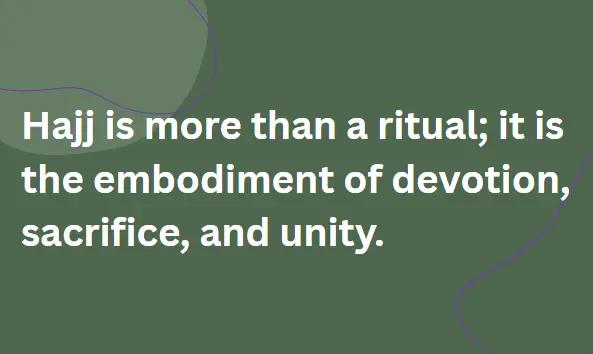Islam is founded on the Five Pillars, which are considered the core acts of worship and devotion that every Muslim is expected to uphold. These pillars are: Shahada (faith), Salah (prayer), Zakah (charity), Sawm (fasting), and Hajj (pilgrimage). While each pillar holds its unique place in a Muslim’s life, Hajj stands out as the most physically demanding and spiritually profound of them all. It is not just a journey to a sacred land; it is a journey inward, toward spiritual purification, humility, and complete submission to the will of Allah.
In this blog, we’ll explore what Hajj is, its rituals, significance, history, and how it ties into the broader framework of Islamic belief and practice.
What is Hajj?
Hajj (الحج) is the annual pilgrimage to the holy city of Makkah (Mecca) in Saudi Arabia, and it is considered the fifth pillar of Islam. It is obligatory once in a lifetime for every adult Muslim who is physically and financially capable of undertaking the journey.
The term “Hajj” literally means “to intend a journey,” and in the Islamic context, it refers to the journey made for the sake of Allah to perform specific rituals during a designated time — the month of Dhul Hijjah, the 12th month of the Islamic calendar.
Quranic Command for Hajj
Allah commands Hajj in the Qur’an:
“And [due] to Allah from the people is a pilgrimage to the House – for whoever is able to find thereto a way.”
(Surah Al-Imran 3:97)
This verse establishes Hajj as an obligation, just like the other pillars of Islam, emphasizing its importance in the life of a believer.
The Conditions of Hajj
For Hajj to be obligatory, several conditions must be met:
- Islam – Only Muslims are required to perform the Hajj.
- Maturity – One must be an adult.
- Sanity – A person must be mentally sound.
- Financial and physical ability – Must have the means and health to undertake the journey.
- Freedom – In classical Islamic law, being free (not enslaved) was also a condition.
When is Hajj Performed?
Hajj is performed during specific days in the Islamic month of Dhul Hijjah, with the main rites taking place from the 8th to the 13th of Dhul Hijjah. Unlike Umrah (a minor pilgrimage), which can be performed any time of the year, Hajj is time-specific and has set rituals that must be followed in a particular order.
The Main Rituals of Hajj: Step-by-Step
Hajj is composed of several rituals, each with deep spiritual and historical significance. Here’s a step-by-step overview:
1. Ihram – State of Sacredness
Pilgrims enter a state of spiritual purity by wearing specific garments — two white seamless cloths for men, and modest clothing for women. In this state, certain actions are prohibited (e.g., cutting hair, arguing, marital relations).
2. Tawaf – Circling the Kaaba
Pilgrims perform seven circuits around the Kaaba, the sacred cube-shaped structure in the Masjid al-Haram. This act symbolizes the unity of believers in the worship of the One God.
3. Sa’i – Walking Between Safa and Marwah
Pilgrims walk seven times between the hills of Safa and Marwah, emulating Hajar’s (Hagar’s) search for water for her son, Isma’il.
4. Standing at Arafat (Wuquf Arafat) – The Heart of Hajj
On the 9th of Dhul Hijjah, pilgrims gather at the plain of Arafat and stand in prayer, repentance, and reflection. This is the most important ritual — missing it invalidates the Hajj. It symbolizes the Day of Judgment and Allah’s mercy and forgiveness.
5. Muzdalifah – Collecting Pebbles
After sunset, pilgrims travel to Muzdalifah, pray, and collect pebbles to use in the next ritual.
6. Ramy al-Jamarat – Stoning the Devil
Pilgrims throw seven pebbles at the largest of three pillars, representing Iblis (Satan), reenacting Prophet Ibrahim’s rejection of the devil’s temptations.
7. Eid al-Adha and Animal Sacrifice
On the 10th of Dhul Hijjah, Muslims worldwide celebrate Eid al-Adha, and pilgrims sacrifice an animal to commemorate Prophet Ibrahim’s willingness to sacrifice his son in obedience to Allah. This act also reflects sharing blessings with the poor.
8. Shaving/Cutting Hair
Men shave their heads or trim their hair; women cut a small portion of their hair. This symbolizes a new beginning and humility before God.
9. Final Tawaf (Tawaf al-Ifadah) and Farewell Tawaf
Pilgrims perform another circuit of the Kaaba to complete the rituals of Hajj before departing.
Spiritual and Social Significance of Hajj
Hajj holds deep spiritual and social significance for Muslims around the world. Spiritually, it serves as a journey of purification, repentance, and renewal, offering a chance to return free of sins, like a newborn. Socially, it unites millions of Muslims from diverse backgrounds, promoting equality, brotherhood, and humility. The shared rituals and experiences reinforce a sense of global Muslim unity and collective submission to Allah.
1. Unity of the Muslim Ummah
Hajj brings together millions of Muslims from every race, nationality, and background, standing shoulder to shoulder in identical clothing, showing that in the sight of Allah, all are equal.
2. Purification and Forgiveness
The Prophet Muhammad (peace be upon him) said:
“Whoever performs Hajj and does not commit any obscenity or wrongdoing will come out as the day he was born — pure from sins.”
(Sahih al-Bukhari)
Hajj is a profound opportunity for spiritual rebirth.
3. Obedience and Submission
Each act of Hajj is rooted in obedience to Allah’s command, from the rituals of Ibrahim (Abraham) to the response of the Prophet Muhammad. Hajj trains the believer in discipline, patience, sacrifice, and complete trust in Allah.
4. Reminder of the Hereafter
From wearing shrouds (Ihram) to standing on Arafat (like standing before Allah), the entire journey of Hajj serves as a reminder of the afterlife and accountability.
Hajj in the Context of the Five Pillars of Islam
Hajj, as the fifth pillar of Islam, completes the framework of a Muslim’s faith and practice. It embodies the essence of the other pillars, faith (Shahada), prayer (Salah), charity (Zakah), and fasting (Sawm)—through physical devotion, spiritual reflection, and communal worship. Hajj brings these pillars to life in a powerful, unified experience of submission to Allah.
Reconnecting with the Other Pillars:
- Shahada (Faith) – The entire Hajj journey is an act of living faith and constant reminders of the oneness of Allah.
- Salah (Prayer) – Daily prayers continue throughout Hajj, reinforcing spiritual discipline.
- Zakah (Charity) – Pilgrims give generously to the needy during Hajj, especially during the sacrifice.
- Sawm (Fasting) – The spiritual self-restraint learned in Ramadan is echoed in Hajj through patience and humility.
- Hajj (Pilgrimage) – Culminates the physical and financial ability to obey Allah’s command, completing the five pillars.
Conclusion:
Hajj is more than a ritual; it is the embodiment of devotion, sacrifice, and unity. It is the climax of a Muslim’s spiritual journey, fulfilling the Fifth Pillar of Islam. While Shahada affirms belief, Salah disciplines it, Zakah purifies it, Sawm strengthens it, and Hajj perfects it through action, sacrifice, and reflection.
For those who perform it with sincerity and devotion, Hajj becomes a life-altering experience, reminding them of their purpose, their Creator, and their place within the global Muslim Ummah.
Whether you’ve yet to make the journey or are preparing for it, the message of Hajj is clear: submit to Allah, purify your heart, and walk the path of those who came before you in faith.






